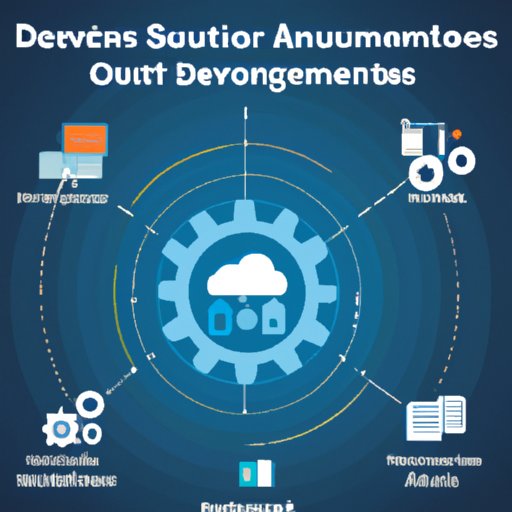Introduction
DevOps teams are increasingly turning to automation as a way to increase efficiency, reduce human error, and streamline processes. But what exactly is automation in DevOps, and how can it benefit your team? In this article, we’ll explore the definition of automation in DevOps, its advantages, use cases, and best practices for implementing automation in your organization.

Understanding Automation in DevOps and Its Benefits
Automation in DevOps is the process of automating manual tasks and operations that would otherwise be performed by humans. This includes activities such as deployment, testing, monitoring, and infrastructure provisioning. Automation helps to speed up the development process, reduce human error, and improve overall efficiency.
There are several advantages to using automation in DevOps:
- Faster development cycles: Automation allows DevOps teams to quickly deploy code changes, test new features, and monitor their systems, resulting in faster development cycles.
- Reduced human error: Automation eliminates manual errors and ensures that tasks are completed accurately and consistently.
- Improved system reliability: Automation helps to ensure that applications and systems remain stable and reliable over time.
- Easier scalability: Automation makes it easier to scale applications and systems as needed.

Exploring the Use Cases of Automation in DevOps
Automation can be used in a variety of areas within DevOps. Here are some common use cases:
Automating Deployment
Deployment automation involves automating the process of deploying code changes from development to production environments. This can include automating the build process, running tests, and pushing code changes to production. Deployment automation helps to speed up the deployment process and reduce manual errors.
Automating Testing
Automated testing allows DevOps teams to quickly and efficiently run tests on their code. This can include unit tests, integration tests, and end-to-end tests. Automated testing helps to reduce the amount of time spent on manual testing and ensures that code changes are tested thoroughly before being deployed.
Automating Monitoring
Monitoring automation involves automating the process of collecting and analyzing data from applications and systems. This can include performance metrics, log files, and system alerts. Automated monitoring helps to ensure that issues are identified quickly and addressed promptly.
Automating Infrastructure Provisioning
Infrastructure provisioning automation involves automating the process of setting up and configuring servers, networks, and storage. This can include spinning up new servers, configuring networks, and setting up storage. Automated infrastructure provisioning helps to reduce the amount of time spent on manual setup and configuration.
Automation Tools for DevOps Teams
There are a number of tools available to help DevOps teams automate their processes. Here are some of the most popular tools:
Configuration Management Tools
Configuration management tools, such as Chef and Puppet, allow DevOps teams to automate the process of configuring and managing servers, networks, and storage. These tools help to ensure that all systems are configured consistently and reliably.
Continuous Integration and Delivery Tools
Continuous integration and delivery (CI/CD) tools, such as Jenkins and Travis CI, allow DevOps teams to automate the process of building, testing, and deploying applications. These tools help to speed up the development process and reduce manual errors.
Container Orchestration Tools
Container orchestration tools, such as Kubernetes and Docker Swarm, allow DevOps teams to automate the process of deploying and managing containerized applications. These tools help to ensure that applications are deployed quickly and reliably.

Best Practices for Implementing Automation in DevOps
Implementing automation in DevOps can be challenging, but there are a few best practices that can help make the process easier:
Start Small and Iterate
It’s important to start small when implementing automation in DevOps. Start with simple tasks and processes, such as automating deployments or running automated tests, and then gradually expand to more complex tasks. This will help to ensure that the automation process is implemented correctly.
Leverage Existing Tooling
There are a number of tools available to help DevOps teams automate their processes. It’s important to leverage existing tooling to avoid having to build custom solutions from scratch. This will help to speed up the implementation process and reduce costs.
Focus on Automating Repetitive Processes
When implementing automation in DevOps, it’s important to focus on automating repetitive processes. This will help to ensure that tasks are completed quickly and accurately, and that resources are used efficiently.
Monitor and Adjust as Needed
Once automation has been implemented, it’s important to monitor the process and adjust as needed. This will help to ensure that the automation process is working as expected and that any issues are identified and addressed promptly.
Conclusion
Automation in DevOps is an essential part of the development process. It helps to reduce manual errors, speed up development cycles, and improve overall efficiency. By leveraging existing tooling, focusing on automating repetitive processes, and monitoring and adjusting as needed, DevOps teams can successfully implement automation in their organizations.
(Note: Is this article not meeting your expectations? Do you have knowledge or insights to share? Unlock new opportunities and expand your reach by joining our authors team. Click Registration to join us and share your expertise with our readers.)
